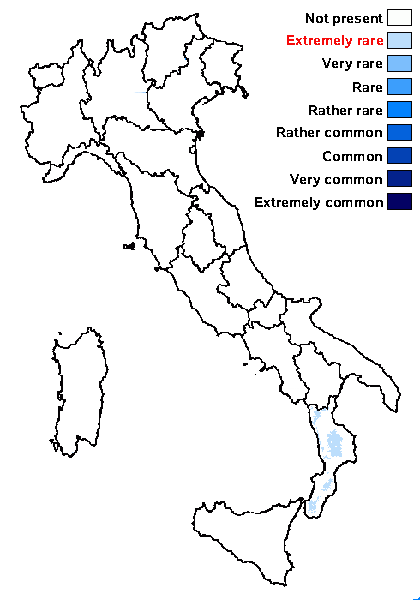Byssoloma llimonae Sérus., Gómez-Bolea, Longán & Lücking
Lichenologist, 34: 184, 2002.
Synonyms:
Distribution: S - Cal (Llop 2007).
Description: Thallus crustose, thinly episubstratic, usually continuous, up to 100 µm thick, slightly farinose, yellowish green, without a distinct prothallus. Apothecia biatorine, rounded, constricted at base, sometimes confluent into sublobate clusters, 0.2-0.5(-0.6) mm across, with a flat to convex, bluish-grey to blackish disc (often becoming brown with age), and a usually paler, slightly raised, smooth to shortly byssoid proper margin. Exciple 50-65(-80) µm thick in outer part, which is composed of short hyphae with elongate to globose cells forming a minutely byssoid margin, the inner part up to 75 µm thick, clearly paraplectenchymatous, of polyhedral, brown cells arranged in radiating rows, reacting K+ purple-brown; epithecium colourless to brownish; hymenium colourless or yellowish, 60-75 µm high; paraphyses rather coherent, simple or sparingly branched, 1-1.5 µm thick, the apical cells up to 3 µm wide; hypothecium orange-brown, 100-150 µm high, K+ purple-brown. Asci 8-spored, clavate, with a K/I+ blue apical dome containing a darker blue, tubular ring-structure, and an amyloid coat, Byssoloma-type. Ascospores 3-5(-7)-septate, clearly constricted at septa, hyaline, narrowly ellipsoid to fusiform, 13-15(-25) x (3-)4-5 µm. Pycnidia pyriform, whitish, bluish grey to black, 0.1-0.15 mm across, usually with a gaping ostiole. Conidia biclavate to obpyriform, sometimes almost bacilliform, 3-4(-5) x c. 1 µm. Photobiont chlorococcoid. Spot tests: thallus K-, C-, KC-, P-, UV-. Chemistry: thallus without lichen substances.Note: a mainly corticolous, sometimes foliicolous species known from the Iberian Peninsula, Macaronesia and Southern Italy, where is certainly extremely rare. It is included in the Italian red list of epiphytic lichens as “Critically Endangered” (Nascimbene & al. 2013c).
Growth form: Crustose
Substrata: bark
Photobiont: green algae other than Trentepohlia
Reproductive strategy: mainly sexual
Restricted to humid-warm, oceanic areas
Commonnes-rarity: (info)
Alpine belt: absent
Subalpine belt: absent
Oromediterranean belt: absent
Montane belt: extremely rare
Submediterranean belt: absent
Padanian area: absent
Humid submediterranean belt: absent
Humid mediterranean belt: absent
Dry mediterranean belt: absent

Predictive model
Growth form: Crustose
Substrata: bark
Photobiont: green algae other than Trentepohlia
Reproductive strategy: mainly sexual
Restricted to humid-warm, oceanic areas
Commonnes-rarity: (info)
Alpine belt: absent
Subalpine belt: absent
Oromediterranean belt: absent
Montane belt: extremely rare
Submediterranean belt: absent
Padanian area: absent
Humid submediterranean belt: absent
Humid mediterranean belt: absent
Dry mediterranean belt: absent

Predictive model
 INDEX FUNGORUM
INDEX FUNGORUM
 GBIF
GBIF

